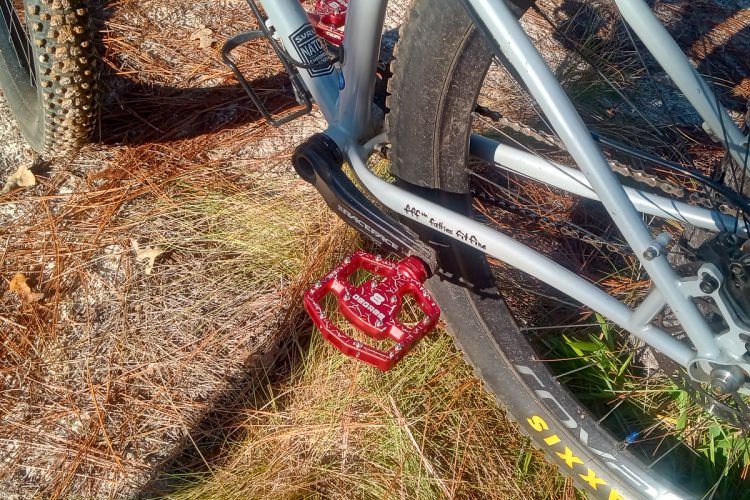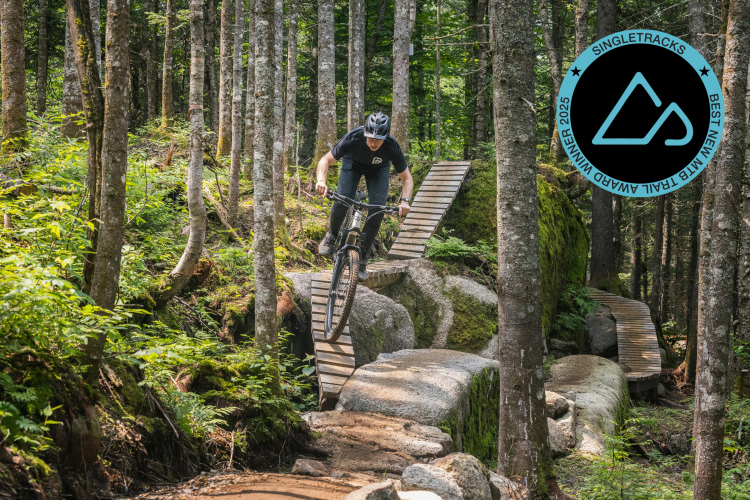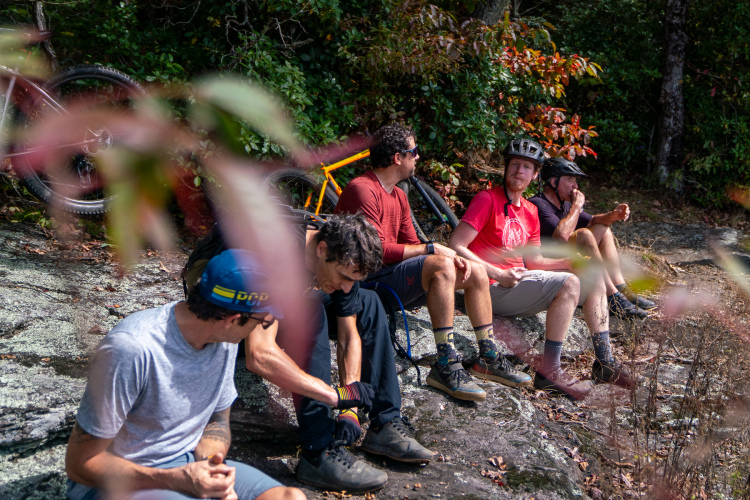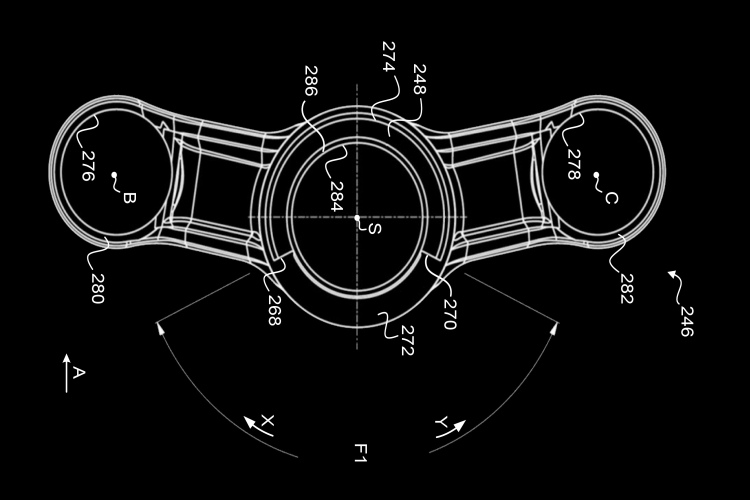First a story…
A couple of years ago a friend of mine who is a former pro rider came out to Colorado and naturally, we went for a bike ride. While he can pretty much drop me at will, through high speed turns it wasespeciallyembarrassing. At one point when he politely waited for me to catch up, Ifinallyasked him what dark magic he was using to so blatantly defy physics. He offered to follow me for a bit, and after we went through one turn he stopped me and condensed all his years of mountain biking experience into one sentence: “Dude, you’re totally doing it wrong.”
The Wrong Way
What was I doing wrong? I’m glad you asked! It turns out that like many riders, I was coming into turns with my crank arms parallel to the ground. Like this:

Photo credit: mtbgreg1
While this works great for downhill and straight lines over uneven terrain, for cornering it’s the wrong approach. This position raises your center of gravity slightly, while preventing you from applying any direct pressure to the bike. You end up limited by the traction of your tires, and even the slightest bump or root will knock you off your line. Instead of directing the bike where you want to go, you end up where the bike wants to go. At best you will make it through your turn white-knuckled and butt-clenched. At worst – well, we’ve all seen those skid marks leading out of the apex of turns and into the bushes…
The Right Way
The correct way to go fast through a turn is to push down hard with the pedal on the outside of the turn, while having the inside pedal at the top of the pedal stroke. Let me break it down in detail.
Let’s suppose we are going into a right-hand turn. (right is this way –>) As we enter the turn, move the pedals such that the left is all the way down, and the right is all the way up. At this point all of your weight should be on the left pedal, the bike is leaned in the direction of the turn, and there is no weight on the right pedal. Also make sure to keep your right knee as close to the top tube as possible. Your torso and the bike will form a straight line from your head down to the ground, like this:

Photo Credit: Andermic Photography
Also make sure to stick out your tongue in the direction of your turn. That part is key.
This position accomplishes several things:
- Your full weight on the outside pedal allows you to leverage physics and drive the tires harder into the ground for added traction.
- Smallobstaclessuch as bumps or roots will be less likely to knock you off your line, due to the increased traction.
- From this position, you can quickly and easily adjust your body further, if needed, due to speed or the nature of the turn.
- When done properly, you will “slingshot” out of the turn, picking up a little speed in the process.
- As you come out of the turn, you are already set up to resume pedaling and gain even more speed.

Photo credit: element22
Notice how the rider above is leaning his body further than the bike. This is called ‘countersteering’ and is useful in extremely fast turns, or when you encounter a turn that issharperthan youanticipated. The directional forces alluded to in Number 1 above are multiplied.
So the next time you hit the trail, pay attention to your how you arecurrentlydoing it and give this technique a try. Your mileage may vary, but I am now powering through turns at roughly 2 – 3 times the speed I used to. If you’re racing, this is a good way to make up time over the whole course, and if you’re on a rec ride, it’s fun to watch your friends faces when they witness the slingshot effect.
Oh, and it turns out I was doing it the right way all along on my road bike. I have no idea why my brain was leading me astray on dirt…
Thanks to mtbgreg1 for modeling the wrong way, even though he normally does it correctly. 😀










18 Comments
Feb 20, 2012
One of the things I learned at the Trestle DH 101 course was to lean your weight onto the inside of your handlebar through a turn. This seems counter-intuitive at first but it actually gives you more grip and keeps you steering into the turn. You can even test this out by setting your bike in the dirt and leaning it to the side and trying to weight both sides of the bars. Weighting the inside will push your tires into the dirt more.
Feb 20, 2012
@trek7k, YES! That pic IS perfect!
@mtbgreg, Funny you should mention skiing because I was just thinking about that when I was skiing last weekend. The principle and physics are identical, you're just substituting a metal edge for tire shoulder treads.
@fleetwood, I don't even think it was that, I think I had just always done it right on pavement, but got sloppy on dirt. And I don't own a road bike per se, I have my old HT mountain bike converted to a commuter, so it's not even like different bike = different style.
As for HT vs FS, this technique works either way. With FS, it absorbs bumps in the turn, with HT it will skip a bit when you hit something, but if you're committed and are driving into the turn really hard, the rear tire will hook up again after the obstacle. It feels a little disconcerting, but it works.
Apr 23, 2012
Apr 23, 2012
I didn't know that before the camp... now I do. Maybe I'll write a follow up post. But just thought I'd throw that out there in case anyone was looking for cornering tips!
Oct 23, 2013
Apr 23, 2012
Feb 20, 2012
Feb 20, 2012
Feb 24, 2012
Feb 20, 2012
@maddlacker - My guess (I don't ride road) is that the difference you were seeing between the road and the trail is because subconsciously you know that on the trail all it takes is a slippery root, loose rock, or soft dirt to put you on the ground and fast. There are not as many variables on the road, although I'm sure there are times when there is some loose debris or the roads are wet that you could get a little shaky.
I think that to rail a turn like that you have to have the technique AND the confidence to know that you are going to come out of it unscathed. The latter might be as much or more to overcome than the former.
Feb 20, 2012
Feb 20, 2012
Feb 20, 2012
Feb 21, 2012
Feb 21, 2012
Feb 20, 2012
However, that doesn't preclude the claim that suspension increases pressure on the ground in certain circumstances. I'm asserting that they are both true.
Feb 20, 2012
Great article! If you're a skier or a snowboarder, this is similar to a nicely carved turn. You really are able to pressure the tires into the turn in this way, thereby increasing your traction. This effect is noticeable on any bike, but it is especially noticeable on a full-suspension mountain bike. With an FS, you are able to compress the suspension going into and through the turn, creating even MORE traction than you could have on a rigid or hardtail.
Just another reason to ride a dualie :D
Feb 20, 2012